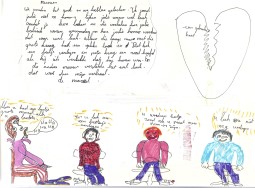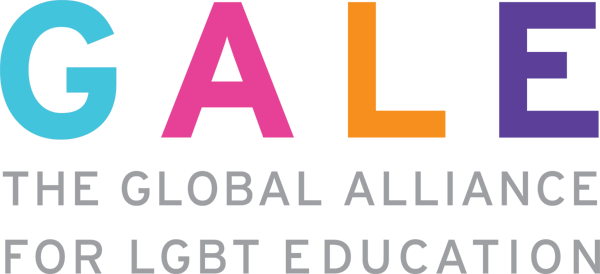Spanish study shows how stories of LGBT teachers can improve initial teacher training

17 August 2023 - A Spanish study explored what impact stories of LGBT teachers can have on students in initial teacher training. The results show how life stories are a good method of raising awareness among trainee teachers by showing the reality of LGBT, including the barriers they may face in schools. In this article the study is summarized and some criticisms on the study are highlighted.
Image: gay and lesbian peer educators drawn by primary school students after a panel session in their class (copyright Peter Dankmeijer)
Life stories
The study did not have an open question, but started with the position that peer-education by LGBTIQ+ educators will have a beneficial effect. This is probably based on the practice of many European LGBTIQ+ associations who ask school to invite young-adult LGBTIQ+ peer-educators for panel sessions in high schools. In this case, the authors suggest to recruit already working LGBTIQ+ teachers to do the same in initial training institutions. In the study, the authors highlight the significance of personal testimonials, but don’t go into the question-and-answer round after the testimonials or how to manage the potential discussion with students about heteronormativity. Research into peer-education show how real-life stories can have a tremendous effect on students when stories are touching, credible and not to far removed from the experience of students themselves. But experiences with LGBTIQ+ peer-education have also shown risks. Peer-educators may not act cis-heteronormative enough and get offensive remarks on their appearance or behavior. They may present their own style and ideas of being LGBTIQ+ as standard, and marginalize other LGBTIQ+ diversities. They may not be trained well enough in handling groups that make prejudiced or offensive comments, which can lead to discussion after the testimonials taking a bad turn. This happens quite often with untrained peer-educators.
The research
The actual study consisted of doing two panel sessions for initial teacher training students of the Jaume I University (Casteló). Five experienced teachers (3 lesbian, 1 gay and 1 trans) shared their life stories with the students. The article doe not give information on whether theses peer-educators had a cis-heteronormative stye of self-expression, or whether they expressed identity aspects that were non-conforming. The participating 101 students got two online surveys. The first had to be answered right after the session and had 15 multiple choice questions. The second was send to students a few days later and had four open-ended questions.
The results showed that students had a very positive attitude towards gender and sexual diversity. They were very supportive for LGBTIQ+ visibility, for LGBTIQ+ teachers telling their stories and thinking such information is important for them. Their scored a bit lower on question on whether these sessions changed their attitude, showing that they probably already had a positive attitude to begin with. High levels of students (71-91%, master/bachelor students) considered that the LGBTIQ+ teacher life stories “could be useful” for their teaching practice, but much less (18-9%) actually did find these particular stories useful. In the remarks students made, recognition of “suffering” of LGBTIQ+ and the need for visibility was prevalent.
Visibility or undoing cis-heteronormativity?
The study describes the situation in school rightly as a cis-heteronormative environment in which practices that privilege and legitimize heterosexuality and gender binarism as considered “natural” and immutable. However, this critical analysis is then reduced to a lack of visibility of LGBTIQ+ people, which in some cases is even equalized with non-cis-heteronormativity. This leads to a simplified and quite traditional view that LGBTIQ+ teachers (and students) need to be more visible and that their stories need to be told “to break the silence”. The authors seem to be unaware that cis-heteronormativity is not limited to (invisibility) or LGBTIQ+ self-identified teachers and that it influences all students and teachers. The undoing of a cis-heteronormative school culture requires a far more thorough change in school culture than just more visibility of LGBTIQ+ teachers. Especially when the visibility of LGBTIQ+ teachers will limited to cis-heteronormative acting teachers, chances are that cis-heteronormative school cultures are being strengthened rather than nuanced.
Acceptance of cis-heteronormative LG(B)T teachers or of diversity
The authors conclude that their study has shown that life stories are a good means of bringing future teachers closer to the different professional and personal realities experienced by LGTBIQ+ teachers. As main benefits of the method are: 1) life stories bring listeners closer to different situations of exclusion that occur in various contexts; 2) the stories raise the awareness of future teachers; 3) they provide an appreciation of the benefits of training in gender diversity as a tool for differentiating from cis-heteronormativity in educational contexts; 4) they enable reflection on the relationship between future teachers and gender diversity.
The general use by the authors of the term “non-cis-heteronormativity” instead of “LGBT” may limit the practical implementation of their conclusions. They don’t give information on the extent that their per-educators where really role models of non-cis-heteronormativity, or if they were mainly cis-heteronormative and therefore more easily acceptable role models for students. There is no information about the actual stories they told, and how these stories added to a greater awareness of diversity – especially diversity that may challenge the sexual and gender expectations of students. Did they discuss non-traditional sexual choices (except same-sex marriage?) Did they discuss attitudes of teachers towards effeminate boys and how to handle classroom bullying of such gender non-conforming students? Did they discuss the plight of trans prostitutes? Or did the peer-educators limit themselves to telling about discrimination they experienced even when they “where just like anyone else” (comment of one of the students)? “Just like anyone else” is usually cis-heteronormative lingo for cis-heteronormativity.
What non-cis-heteronormative role modelling can look like
The aim of “creating awareness” by focusing on the challenges LGBTIQ+ teachers face is likely to create some empathy from initial teacher training students who are already in favor of equal treatment or of appreciation of diversity. But less supportive teacher training students may not feel such empathy, when they judge that teachers who behave in a non-cis-heteronormative way deserve negative feedback for being (what they perceive as) “a bad example for students”.
Role modelling theory has proposed that role modelling works best when “victims of discrimination” do not only tell stories about victimization, but also how they faced such situations and where able to overcome them. The focus then should more be on overcoming challenges than on the difficulties themselves. It would also help when the stories do not press the specificity of LGBTIQ+ challenges, but focus on how such forms of marginalization could happen to anyone, so all students could learn from these experiences.
Peter Dankmeijer


